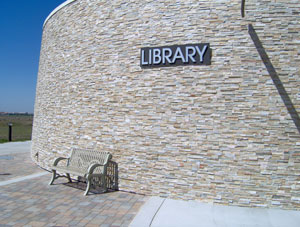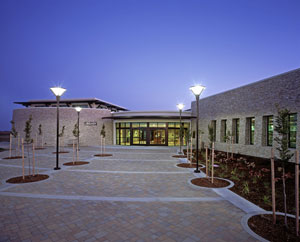Natural Modular Stone Systems: An Important Advancement in Mankind's First Building Material
Design Efficiency
Natural modular stone is now able to offer design teams a design efficiency not provided by the traditional use of bedrock stone. These modular systems are available in many different families of stone-slate, quartzite, granite, basalt, limestone, sandstone, etc. Within each of these families, different colors and styles are available with the same production values and consistency that keeps installation times short and costs low. Beyond different colors, each system includes complementing components that will provide the finishing touches on columns, pool sides, or walls. The design efficiency is provided in the fact that once a designer becomes familiar with the different types of stone and colors, a design team can easily specify very different looks for different projects, without learning an entirely new system of product.
This efficiency is paired with a unique and high quality look and added value through streamlined design, installation and estimation. These benefits can be enjoyed by not only architects and designers, but installers, building owners and homeowners alike.
Lincoln Public Library at Twelve Bridges |
||||||
The city of Lincoln, California was building a new main library as part of a joint venture between the City of Lincoln, the Sierra Community College District, and the Western Placer Unified School District. "A library is a testament to stability and progress in a town," said the   Architect of Record Jordan Knighton, AIA, NCARB, and Partner of NTD Architecture. "Initially, we wanted to use localized rock throughout this project to reflect the cultural history of the area in this contemporary building designed to foster learning and advancement." The project was a public contract and expensive labor laws in California made the traditional, labor-intensive avenue of using full-bed natural stone cost prohibitive. The design team still wanted to use a durable material, that would, like the library, stand the test of time.  Natural modular stone systems were able to couple the natural stone aesthetic and durability with a significant labor savings, so that the total cost of the stone system fell within the pricing parameters of the public contract.
"Even though we were not able to incorporate local material, we were able to create the natural stone aesthetic, on budget," said Knighton. "And the rock palette available in the natural modular stone system offered a variety of colors and textures, enabling the design team to use different colors and styles within one family of stone to create a very textured and interesting complex." |
Â
Differences in Natural Modular Stone Systems
Natural modular stone systems optimize the use of real stone for construction projects making installation easier and providing a new level of product consistency that previously did not exist with real stone. Although all of these systems, from all different companies, use real stone, not all natural modular stone systems are created equal. Here are a few differentiating factors to be aware of when determining which natural stone product to place in a design.
All Stone is Not Cut Equally
Look at the thickness of the individual stones in the module. Typically, thicker stone has more integrity than thinner stone and is better equipped to withstand its own gravity or an impact. Thicker stone is often slightly more costly due to necessary anchoring materials and more expensive to ship, because the thicker product is heavier. With certain styles, thickness dramatically affects the look and feel of the completed job and changes the emotional reaction to the project.
Differences in Glue
Some adhesives are more brittle than others and/or more susceptible to breaking down or cracking in heat or sun. If the glue is exposed to the elements for any period of time at any stage of manufacture, shipping, storage, delivery, or on-site, the glue could break down and the assembled stone panel could fall apart. Glues should be flexible and UV resistant to better manage this problem.Â
The Importance of Packaging
The packaging of these different modular units should be protective, easily transported and easily identifiable. Some companies ship their panels loosely in unprotected bundles in a crate or on a pallet. The individual panels are not protected during shipping or the construction process, which significantly increases the likelihood of scuffing, chipping and breakage. Â
Look for materials that are boxed within a crate, making it both easy to move via mechanical means (forklift) and by hand, box-by-box. This convenient packaging means better job stocking ability and movement around the job for more efficient installation, as well as easier removal and transport of leftover material. For the best end results, every panel should be conveniently packaged and protected.
The packaging should also clearly identify the product contained within. Clear labeling minimizes the opportunity for ordering, delivery and installation errors.Â
Mesh or No Mesh
The use of mesh on the back of a natural stone panel communicates a lot about the quality of the product. Companies sometimes put mesh on the back of the assembled rocks to help hold them in place in case the internal structure of the panel cracks. Panels can crack as a result of using poor quality glue during assembly or inadequate protection during shipping. With the mesh in place, the cracked panel will not appear broken.
Placing mesh on the back of the natural stone panels may compromise the installation. When panels are installed, the natural stone panel is set into a mortar coating that covers the originally constructed surface. It is important that the rock firmly bond itself to the mortar. The presence of the mesh can compromise the bond between the rock and the mortar and create an installation with questionable integrity.
Panels built without mesh have often been constructed with better glues, stone with more integrity, or a cleaner assembly process and are usually thought to be a higher quality product.
Stepped Panels vs. Standard Rectangular Panels
Panels are available in either a standard rectangular panel or a stepped panel. Stepped panels were designed to break up the vertical seam that can occur when rectangular panels are aligned, by offsetting the panel in the middle. While the aesthetic motivation behind the selection of these products is clear, the shortcomings of the stepped panel may only be revealed during installation and may end up damaging the overall aesthetic more than it improves it. The danger lies in the fact that stepped panels have more surfaces, both vertical and horizontal, than the standard rectangular panel. This equates to more surfaces that must be cleaned and tightly fitted during installation and an overall more challenging puzzle of panel pieces.
Consider the installation of a dry stacked modular system. A dry stacked modular system is designed to replicate the practice of dry stacking stones, which means, literally, without using mortar. In order for dry stacked modular systems to retain their full aesthetic value, they must be precisely fit together, so that no mortar is visible between the units. As the number of surfaces that need to fit together grows, the installation process slows and the opportunity for poor installation increases.
While most of the panels in the stepped system will be stepped panels, rectangular panes will still need to be used to fit the stepped panels into the corners. This change from stepped to standard that occurs in every corner of the project may cause more visual noise than a consistent seam from aligning rectangular panels throughout the project.
It requires more stepped panels than rectangular panels to cover an area. This is because the shape of the stepped panel with a step on each side makes it less efficient at covering an area than the rectangular shape. The standard rule of thumb is that stepped panels yield 12.5 percent less on a job than a rectangular panel. That represents a significant difference in both the materials and labor necessary to complete the installation.
ÂAfter centuries of using traditional full-bed stone and decades of settling for molded concrete that looks like stone, there is a new stone solution: natural modular stone systems. Made from real stone, these products offer the timeless beauty, durability, ease of maintenance, and sustainability that has made full-bed stone so popular. In addition, by adding an assembly process between the quarry and the job site, these products also offer the color consistency, production rate, designability and ability to accurately job cost that has differentiated artificial stone from full-bed stone for so long.  Natural modular stone systems make designing with stone easy and cost-effective. It is real stone made simple.
Â
|











